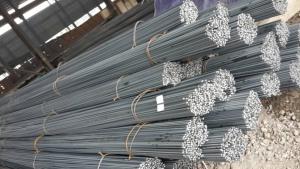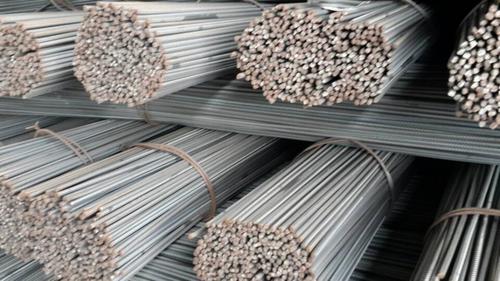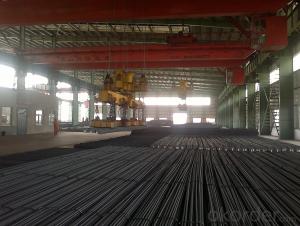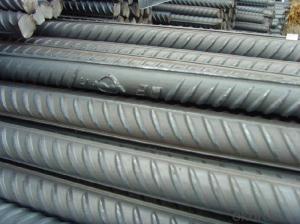HR Steel Deformed Rebar ASTM Standard
- Loading Port:
- China Main Port
- Payment Terms:
- TT or LC
- Min Order Qty:
- -
- Supply Capability:
- -
OKorder Service Pledge
OKorder Financial Service
You Might Also Like
Product Description:
OKorder is offering HR Steel Deformed Rebar ASTM Standard at great prices with worldwide shipping. Our supplier is a world-class manufacturer of steel, with our products utilized the world over. OKorder annually supplies products to African, South American and Asian markets. We provide quotations within 24 hours of receiving an inquiry and guarantee competitive prices.
Product Applications:
HR Steel Deformed Rebar ASTM Standard are ideal for structural applications and are widely used in the construction of buildings and bridges, and the manufacturing, petrochemical, and transportation industries.
Product Advantages:
OKorder's HR Steel Deformed Rebar ASTM Standard are durable, strong, and wide variety of sizes.
Main Product Features:
· Premium quality
· Prompt delivery & seaworthy packing (30 days after receiving deposit)
· Can be recycled and reused
· Mill test certification
· Professional Service
· Competitive pricing
Product Specifications:
Manufacture: Hot rolled
Grade: Gr40
Size: 6mm-32mm
Certificates: ISO, SGS, BV, CIQ
Length: 6m – 12m, as per customer request
Packaging: Export packing, nude packing, bundled
| DEFORMED BAR | |
| SIZE d(mm) | theoretical kg/m |
| 6 | 0.222 |
| 8 | 0.395 |
| 10 | 0.617 |
| 12 | 0.888 |
| 14 | 1.21 |
| 16 | 1.58 |
| 18 | 2 |
| 20 | 2.47 |
| 22 | 2.98 |
| 25 | 3.85 |
| 28 | 4.83 |
| 32 | 6.31 |
FAQ:
Q1: Why buy Materials & Equipment from OKorder.com?
A1: All products offered byOKorder.com are carefully selected from China's most reliable manufacturing enterprises. Through its ISO certifications, OKorder.com adheres to the highest standards and a commitment to supply chain safety and customer satisfaction.
Q2: How do we guarantee the quality of our products?
A2: We have established an advanced quality management system which conducts strict quality tests at every step, from raw materials to the final product. At the same time, we provide extensive follow-up service assurances as required.
Q3: what is the difference between actual weight and theoretical weight?
A3: All the section steel has two weights: actual weight and theoretical weight. Actual weight is the weighing out when the product delivered from the mill. Theoretical weight is calculated by pieces. The invoice can be based on each of them as your request.
Images:
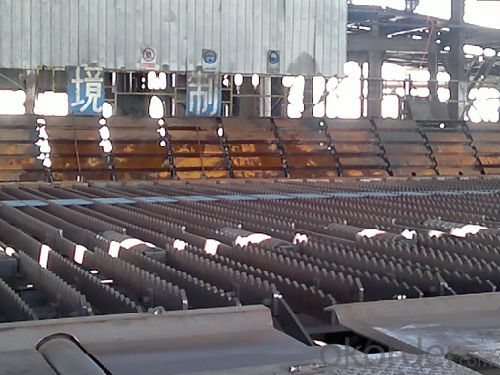
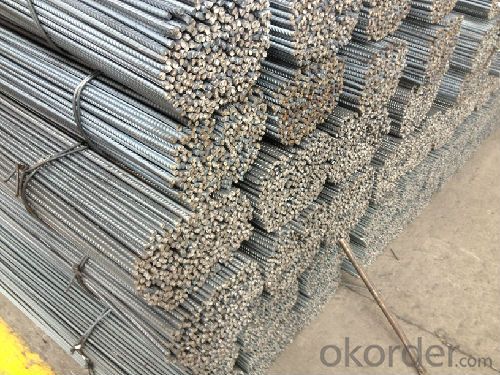
- Q: What is the corrosion resistance of steel rebars?
- The corrosion resistance of steel rebars is generally high due to the presence of a protective oxide layer on the surface of the steel. However, in certain environments, such as those with high levels of moisture or exposure to corrosive substances, the rebars may be susceptible to corrosion. Therefore, additional measures such as proper concrete cover, epoxy coating, or galvanization are often employed to enhance the corrosion resistance of steel rebars.
- Q: Are steel rebars susceptible to rust?
- Yes, steel rebars are susceptible to rust. Rebars are typically made of carbon steel, which contains iron. When exposed to moisture and oxygen, iron reacts to form iron oxide, commonly known as rust. This process is accelerated in the presence of salt or other corrosive substances. Rust formation weakens the rebars and can eventually lead to structural damage if left untreated. Therefore, it is crucial to protect steel rebars by applying an appropriate coating or using other corrosion prevention methods to ensure the longevity and structural integrity of reinforced concrete structures.
- Q: Are steel rebars susceptible to stress corrosion cracking?
- Yes, steel rebars are susceptible to stress corrosion cracking, particularly in environments with high chloride content such as coastal regions or areas with deicing salts. The combination of tensile stress, corrosion, and the presence of certain corrosive agents can lead to the formation and propagation of cracks, compromising the structural integrity of the rebars.
- Q: What are the advantages of using epoxy-coated stainless steel rebars?
- Epoxy-coated stainless steel rebars offer a variety of benefits. Firstly, the addition of epoxy coating enhances the rebars' corrosion resistance by acting as a barrier against moisture, chemicals, and other corrosive elements. This extends the rebars' lifespan and ensures the durability of the structure. Secondly, the epoxy coating improves the bond strength between the rebar and concrete by creating a rough surface texture. This results in a stronger overall structure. Another advantage is that the epoxy coating provides a smooth surface, making the rebars easier to handle and install during construction. It also eliminates the risk of injury from sharp edges. Furthermore, epoxy-coated stainless steel rebars are environmentally friendly as they do not contain harmful substances like lead or heavy metals. This makes them a sustainable choice for environmentally conscious projects. Lastly, these rebars require minimal maintenance due to the protective layer provided by the epoxy coating. This saves time, costs, and minimizes disruptions to ongoing construction projects. In conclusion, the benefits of using epoxy-coated stainless steel rebars include enhanced corrosion resistance, improved bond strength, ease of handling and installation, environmental friendliness, and reduced maintenance requirements. These advantages make them a reliable and cost-effective choice for reinforcing concrete structures.
- Q: How do steel rebars affect the overall construction cost?
- Steel rebars can significantly affect the overall construction cost. While they add to the initial expenses, their use improves the structural integrity and durability of the building. By providing strength and reinforcement to concrete structures, steel rebars reduce the risk of cracks, deformation, and collapse over time. In the long run, this can lead to savings in maintenance and repair costs, making steel rebars a cost-effective investment in construction projects.
- Q: What are the guidelines for repairing damaged steel rebars in a structure?
- When it comes to repairing damaged steel rebars in a structure, there are several guidelines that need to be followed to ensure the structural integrity of the building. Here are some key guidelines: 1. Inspection: Before starting the repair process, a thorough inspection of the damaged rebars should be conducted. This includes assessing the extent of the damage, identifying the cause of the damage, and determining whether repair is feasible or if replacement is required. 2. Cleaning: The damaged rebars need to be cleaned properly to remove any loose rust, scale, or other contaminants. This can be done using wire brushes, sandblasting, or other appropriate cleaning methods. 3. Removal of damaged material: Any corroded or severely damaged portions of the rebars should be removed. This may involve cutting out the damaged area and replacing it with a new rebar, or using techniques such as welding or epoxy bonding to repair the damaged section. 4. Surface preparation: The surface of the rebars should be prepared to ensure proper adhesion of the repair material. This may involve roughening the surface, applying a bonding agent, or using other surface preparation techniques depending on the specific repair method being employed. 5. Repair material selection: The choice of repair material will depend on factors such as the severity of the damage, the load-bearing capacity required, and the environment in which the rebars are located. Common repair materials include epoxy resins, cementitious mortars, or other specialized repair products. 6. Repair technique: The repair technique chosen should be appropriate for the specific damage and should comply with relevant industry standards and codes. Techniques such as welding, epoxy bonding, or mechanical splicing can be used to repair damaged rebars. 7. Quality control: Throughout the repair process, quality control measures should be implemented to ensure the effectiveness and durability of the repair. This may involve testing the repaired rebars for strength, monitoring the curing process, and conducting inspections to verify that the repairs have been carried out in accordance with the guidelines. 8. Documentation: It is essential to maintain thorough documentation of the repair process, including photographs, test results, and any relevant certifications or warranties. This documentation can be useful for future reference, maintenance, and to provide evidence of the repair work done. It is important to note that the guidelines for repairing damaged steel rebars may vary depending on the specific requirements of each project, local building codes, and the recommendations of structural engineers or repair specialists. Therefore, it is crucial to consult with experts in the field to ensure that the repair work is carried out safely and effectively.
- Q: What are the dimensions and sizes of steel rebars?
- Steel rebars, also known as reinforcing bars, come in various dimensions and sizes to suit different construction needs. The most common sizes of steel rebars are typically between 6 to 40 millimeters in diameter, with the most frequently used sizes being 10, 12, 16, 20, and 25 millimeters. The length of steel rebars can vary depending on the project requirements, but they are commonly available in lengths ranging from 6 to 18 meters.
- Q: What are the main uses of steel rebars?
- Steel rebars, otherwise known as reinforcing bars, serve as a crucial component in construction and civil engineering endeavors, granting robustness and steadiness to concrete structures. The primary applications of steel rebars encompass the following: 1. Reinforcement of Concrete: Steel rebars are strategically integrated within concrete structures to heighten their tensile strength. While concrete exhibits commendable resistance against compressive forces, it remains vulnerable in terms of tension. By incorporating rebars, the resulting composite material (reinforced concrete) is endowed with the ability to withstand both compressive and tensile forces, rendering it suitable for various applications such as building columns, beams, slabs, and foundations. 2. Enhancement of Structural Stability: Steel rebars play a pivotal role in elevating the structural stability of edifices and infrastructures. They facilitate the uniform distribution of loads across the structure, preventing the occurrence of cracks, sagging, or collapse. Through the reinforcement of concrete elements with rebars, structures become capable of enduring substantial loads, seismic activity, and other external forces. 3. Bridges and Highways: Steel rebars find extensive employment in the construction of bridges and highways. As bridges are routinely subjected to substantial loads and harsh environmental conditions, robust and durable reinforcement is imperative. Steel rebars ensure the longevity and structural integrity of these critical infrastructure projects. 4. Retaining Walls and Tunnels: Retaining walls serve the purpose of holding back soil or other substances, thereby preventing erosion. Steel rebars are commonly employed to reinforce these structures, enabling them to withstand the lateral pressures exerted by the retained material. Similarly, in tunnel construction, rebars bestow strength upon the concrete lining, ensuring stability and averting collapse. 5. Foundations: Steel rebars form an indispensable constituent in the construction of building foundations. They contribute to the even distribution of the structure's weight onto the ground, thereby averting the occurrence of settlement or sinking. Furthermore, rebars anchor the foundation to the ground, endowing it with stability against soil movement or seismic forces. 6. Pre-stressed and Post-tensioned Concrete: In the realm of pre-stressed and post-tensioned concrete construction, steel rebars are employed to introduce compressive forces into the concrete members. This technique elevates the structural performance by diminishing tensile stress, augmenting load-bearing capacity, and minimizing cracking. 7. Masonry Reinforcement: Steel rebars are also utilized to reinforce masonry structures such as walls, columns, and arches. By embedding rebars within mortar joints or cores, the overall strength and stability of the masonry system are enhanced, enabling it to withstand lateral loads and seismic forces. To summarize, steel rebars are indispensable in contemporary construction endeavors, furnishing concrete structures with strength, stability, and durability. By virtue of their capacity to resist tensile forces, they ensure the well-being and longevity of buildings, bridges, highways, tunnels, and other crucial infrastructure projects.
- Q: Can steel rebars be used in coastal construction?
- Yes, steel rebars can be used in coastal construction. Steel rebars are commonly used in coastal construction due to their high strength and durability. They have excellent resistance to corrosion, which is crucial in coastal areas where the presence of saltwater and high humidity can lead to accelerated corrosion of building materials. Additionally, steel rebars can withstand the forces of the waves and strong winds typically experienced in coastal regions. They are able to provide the necessary structural support for buildings, bridges, seawalls, and other coastal infrastructure. However, it is important to ensure proper protective measures are taken, such as using corrosion-resistant coatings or stainless steel rebars, to further enhance their durability and longevity in coastal environments.
- Q: What are the guidelines for the proper spacing of steel rebars in beams?
- The guidelines for the proper spacing of steel rebars in beams typically depend on the specific design requirements and the structural engineer's recommendations. However, in general, rebars should be spaced evenly throughout the beam to ensure adequate structural integrity and load-bearing capacity. The spacing should be determined based on factors such as the beam's dimensions, the anticipated loads, and the type of reinforcement being used. It is essential to follow the relevant building codes and industry standards to ensure the proper spacing of rebars in beams for optimal structural performance.
Send your message to us
HR Steel Deformed Rebar ASTM Standard
- Loading Port:
- China Main Port
- Payment Terms:
- TT or LC
- Min Order Qty:
- -
- Supply Capability:
- -
OKorder Service Pledge
OKorder Financial Service
Similar products
Hot products
Hot Searches
Related keywords


